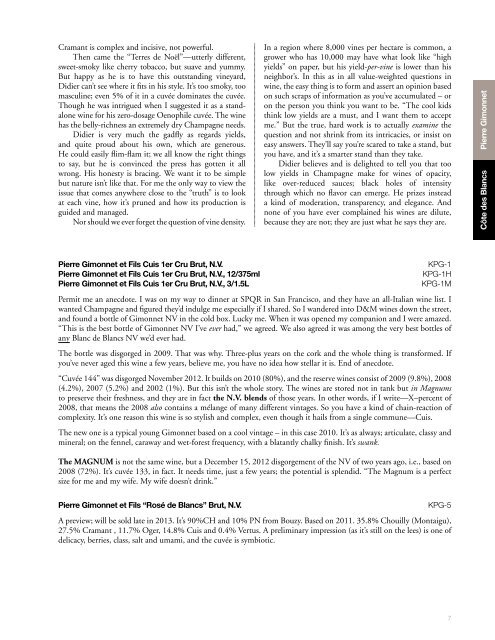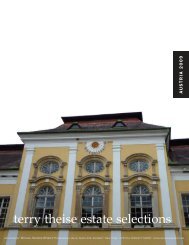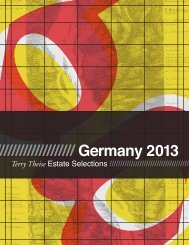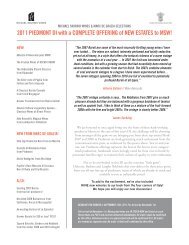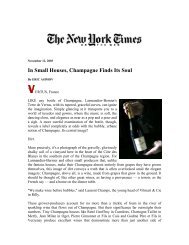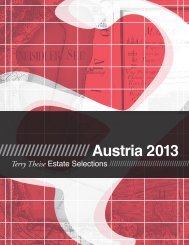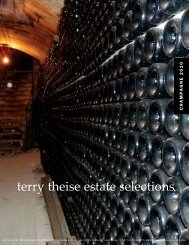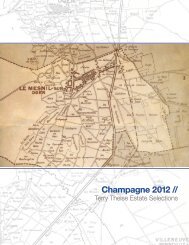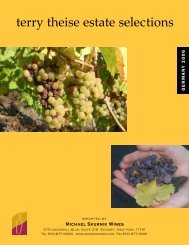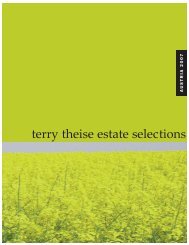View 2013 Champagne Catalog - Michael Skurnik Wines
View 2013 Champagne Catalog - Michael Skurnik Wines
View 2013 Champagne Catalog - Michael Skurnik Wines
Create successful ePaper yourself
Turn your PDF publications into a flip-book with our unique Google optimized e-Paper software.
Cramant is complex and incisive, not powerful.<br />
Then came the “Terres de Noël”—utterly different,<br />
sweet-smoky like cherry tobacco, but suave and yummy.<br />
But happy as he is to have this outstanding vineyard,<br />
Didier can’t see where it fits in his style. It’s too smoky, too<br />
masculine; even 5% of it in a cuvée dominates the cuvée.<br />
Though he was intrigued when I suggested it as a standalone<br />
wine for his zero-dosage Oenophile cuvée. The wine<br />
has the belly-richness an extremely dry <strong>Champagne</strong> needs.<br />
Didier is very much the gadfly as regards yields,<br />
and quite proud about his own, which are generous.<br />
He could easily flim-flam it; we all know the right things<br />
to say, but he is convinced the press has gotten it all<br />
wrong. His honesty is bracing. We want it to be simple<br />
but nature isn’t like that. For me the only way to view the<br />
issue that comes anywhere close to the “truth” is to look<br />
at each vine, how it’s pruned and how its production is<br />
guided and managed.<br />
Nor should we ever forget the question of vine density.<br />
In a region where 8,000 vines per hectare is common, a<br />
grower who has 10,000 may have what look like “high<br />
yields” on paper, but his yield-per-vine is lower than his<br />
neighbor’s. In this as in all value-weighted questions in<br />
wine, the easy thing is to form and assert an opinion based<br />
on such scraps of information as you’ve accumulated – or<br />
on the person you think you want to be. “The cool kids<br />
think low yields are a must, and I want them to accept<br />
me.” But the true, hard work is to actually examine the<br />
question and not shrink from its intricacies, or insist on<br />
easy answers. They’ll say you’re scared to take a stand, but<br />
you have, and it’s a smarter stand than they take.<br />
Didier believes and is delighted to tell you that too<br />
low yields in <strong>Champagne</strong> make for wines of opacity,<br />
like over-reduced sauces; black holes of intensity<br />
through which no flavor can emerge. He prizes instead<br />
a kind of moderation, transparency, and elegance. And<br />
none of you have ever complained his wines are dilute,<br />
because they are not; they are just what he says they are.<br />
Pierre Gimonnet<br />
Côte des Blancs<br />
Pierre Gimonnet et Fils Cuis 1er Cru Brut, N.V.<br />
Pierre Gimonnet et Fils Cuis 1er Cru Brut, N.V., 12/375ml<br />
Pierre Gimonnet et Fils Cuis 1er Cru Brut, N.V., 3/1.5L<br />
KPG-1<br />
KPG-1H<br />
KPG-1M<br />
Permit me an anecdote. I was on my way to dinner at SPQR in San Francisco, and they have an all-Italian wine list. I<br />
wanted <strong>Champagne</strong> and figured they’d indulge me especially if I shared. So I wandered into D&M wines down the street,<br />
and found a bottle of Gimonnet NV in the cold box. Lucky me. When it was opened my companion and I were amazed.<br />
“This is the best bottle of Gimonnet NV I’ve ever had,” we agreed. We also agreed it was among the very best bottles of<br />
any Blanc de Blancs NV we’d ever had.<br />
The bottle was disgorged in 2009. That was why. Three-plus years on the cork and the whole thing is transformed. If<br />
you’ve never aged this wine a few years, believe me, you have no idea how stellar it is. End of anecdote.<br />
“Cuvée 144” was disgorged November 2012. It builds on 2010 (80%), and the reserve wines consist of 2009 (9.8%), 2008<br />
(4.2%), 2007 (5.2%) and 2002 (1%). But this isn’t the whole story. The wines are stored not in tank but in Magnums<br />
to preserve their freshness, and they are in fact the N.V. blends of those years. In other words, if I write—X–percent of<br />
2008, that means the 2008 also contains a mélange of many different vintages. So you have a kind of chain-reaction of<br />
complexity. It’s one reason this wine is so stylish and complex, even though it hails from a single commune—Cuis.<br />
The new one is a typical young Gimonnet based on a cool vintage – in this case 2010. It’s as always; articulate, classy and<br />
mineral; on the fennel, caraway and wet-forest frequency, with a blatantly chalky finish. It’s swank.<br />
The MAGNUM is not the same wine, but a December 15, 2012 disgorgement of the NV of two years ago, i.e., based on<br />
2008 (72%). It’s cuvée 133, in fact. It needs time, just a few years; the potential is splendid. “The Magnum is a perfect<br />
size for me and my wife. My wife doesn’t drink.”<br />
Pierre Gimonnet et Fils “Rosé de Blancs” Brut, N.V.<br />
KPG-5<br />
A preview; will be sold late in <strong>2013</strong>. It’s 90%CH and 10% PN from Bouzy. Based on 2011. 35.8% Chouilly (Montaigu),<br />
27.5% Cramant , 11.7% Oger, 14.8% Cuis and 0.4% Vertus. A preliminary impression (as it’s still on the lees) is one of<br />
delicacy, berries, class, salt and umami, and the cuvée is symbiotic.<br />
7


